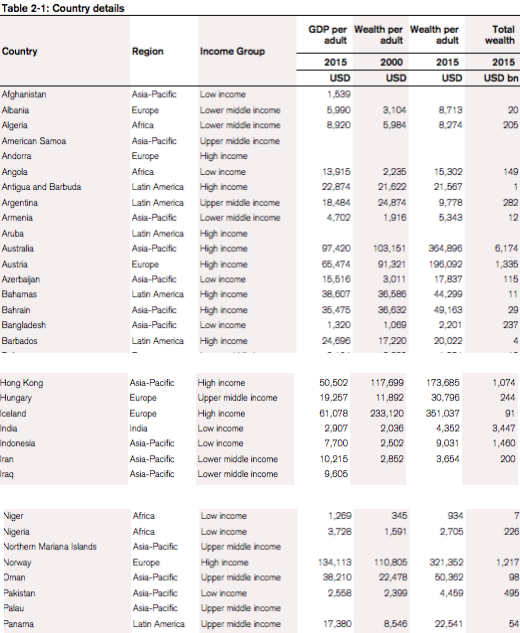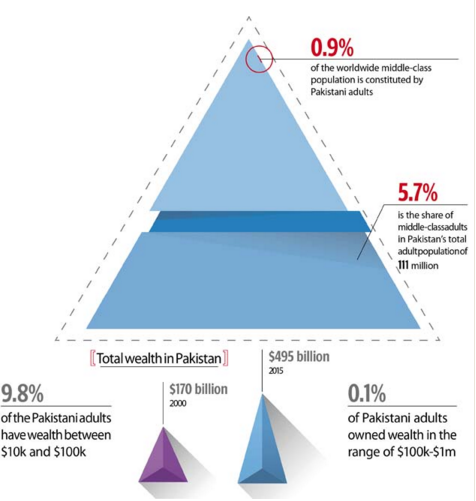PakAlumni Worldwide: The Global Social Network
Pakistan’s middle class consists of over 6.27 million adults, according to wealth criteria used by Credit Suisse in its Global Wealth Report 2015. It represents 5.7% share of Pakistan’s total adult population of 111 million, almost twice as large as India’s middle class made up of 3% of its adult population based on the same criteria.
Average ($4,459) and median ($2,216) wealth figures for Pakistani middle class adults are higher than average ($4,352) and median ($868) wealth figures for their Indian middle class counterparts. It's a consequence of lower income wealth inequality in Pakistan compared to its neighbor. For comparison, only 1.1% of Bangladesh adult population qualify as middle class. Their average wealth is $2,201 and median wealth $1,102 per adult.
Pakistan Wealth Source: Global Wealth Report 2015 Via Express Tribune |
Credit Suisse's report estimates Pakistan's total private wealth in mid-2015 at $495 billion, Bangladesh's at $237 billion and India's at $3.45 trillion.
Credit Suisse said Pakistan's middle class is the 18th largest and India's 8th largest in the world. The report says 14% of world adults qualify as middle class in 2015 and they own 32% of the world's wealth. 6.7 million Pakistani adults make up 0.9% of the world's middle-class adult population. China tops the list with 108.7 million, followed by the United States 91.8 million and Japan 62 million.
A little more than 90% Pakistani adults had wealth less than $10,000 in 2015. The share of Pakistani adults with wealth between $10,000 and $100,000 in 2015 was 9.8% while only 0.1% adults owned wealth in the range of $100,000 and $1 million, the report revealed.
Other studies based on income criteria of $2 or more per day put Pakistan's middle class at 55% of the population. A 2010 ADB report titled "Asia's Emerging Middle Class: Past, Present and Future" report put Pakistan's middle class growth from 1990 to 2008 at 36.5%, much faster than India's 12.5% growth in the same period. Other reports have indicated Pakistan's median per capita income is higher than both India's and Bangladesh's.
Even though Pakistan's GDP growth has been relatively low compared to India and Bangladesh in recent years, the country's middle class has continued to grow rapidly. It's explained as follows: It's not the overall GDP growth and average per capita income and wealth increases but the median per capita income and wealth growth that tells you how the GDP gains are shared among the population.
Data shows that economic gains in Pakistan are shared better than India and Bangladesh because of lower inequality. Income poverty rate (those below $1.25 per capita per day) in India is 33% and Bangladesh 43% versus 13% in Pakistan, according to WB data on povcalNet. Gini Index for India is 33, Pakistan 29 and Bangladesh 32, indicating that Pakistan has lower inequality.
Related Links:
Pakistan's Middle Class Grows to 55%
Median Per Capita Incomes of Bangladesh, India and Pakistan
India and Pakistan Compared in 2014


Riaz Haq
Local car sales jump 72% in Pakistan
KARACHI: Local car sales (including light commercial vehicles, jeeps and vans) jumped to 54,812 units in the first three months (Jul-Sep) of fiscal year 2016, up 72% compared to 31,899 units in the same period of last year, according to data released by the Pakistan Automotive Manufacturers Association (PAMA).
It is important to note that in September 2015, despite fewer working days due to Eidul Azha, local car sales rose 45% year-on-year (YoY) to 18,424 units. They, however, declined by 10% month-on-month (MoM).
The overall healthy growth in the auto sector is indicative of an increase in per capita income, lower interest rates and overall recovery of the economy. Car financing is also picking up gradually (currently estimated at 30% versus 5% a few years ago).
To recall, car sales (excluding imported ones) in Pakistan grew at a five-year (FY11-15) compound annual growth rate (CAGR) of 5.3% to 179,953 units. While volumes surged by 31% in fiscal year 2015 (FY15) on the back of the new model of Toyota Corolla, Punjab taxi scheme and an increase in car financing due to 42-year low interest rates in the country also helped.
“We forecast local car sales to grow at 13% in FY16 to reach 203,653 units,” Topline Securities reported on Monday.
Amongst individual companies, Pak Suzuki sales increased by 98% YoY to 33,770 units in 1QFY16 primarily due to the taxi scheme. Volumes declined by 12% MoM.
Indus Motor sold 14,767 units in 1QFY16 compared to 9,862 units in the same quarter last year. In the month of September, Indus Motor’s sales stood at 4,984 units which rose by 6% year on year. On a MoM basis, however, following the trend in Pak Suzuki, Indus sales also decreased by 10%.
Honda Cars sold 6,184 units in 1QFY16 compared to 4,887 units in the same period last year. In September, Honda Cars sold 2,001 units, up by 14% YoY, while remained flat on a MoM basis.
http://tribune.com.pk/story/971872/local-car-sales-jump-72/
Oct 18, 2015
Riaz Haq
I did visit Pew Global and found a July 2015 report " A Global Middle Class Is More Promise than Reality".
http://www.pewglobal.org/files/2015/07/Global-Middle-Class-Report_F...
It shows the following:
Population Below $2 a day India 19.8% in 2011 down from 35.4% in 2001 vs Pakistan 18.1% in 2011 down from 33.3% in 2001
Median Daily Per Capita Income India $2.96 in 2011 up from $2.39 in 2001 vs Pakistan $2.95 in 2011 up from $2.42 2001
While median daily per capita income is about the same, Pakistan still has lower $2 a day poverty level than India.
Anyone above $2 a day is considered middle class by both ADB and World Bank definitions.
http://www.pewglobal.org/files/2015/07/Global-Middle-Class-Report_F...
Oct 24, 2015
Riaz Haq
Credit Suisse Wealth Report 2017
India Average Wealth Per Capita $5,976 Gini 83% Household Wealth Up 9.9% since 2016
India Median Wealth Per Capita $1295
Pakistan Average Wealth Per Capita $5,174 Gini 52.6% Household Wealth Up 6.3% since 2016
Pakistan Median Wealth Per Capita $3,338
http://publications.credit-suisse.com/tasks/render/file/index
Nov 27, 2017